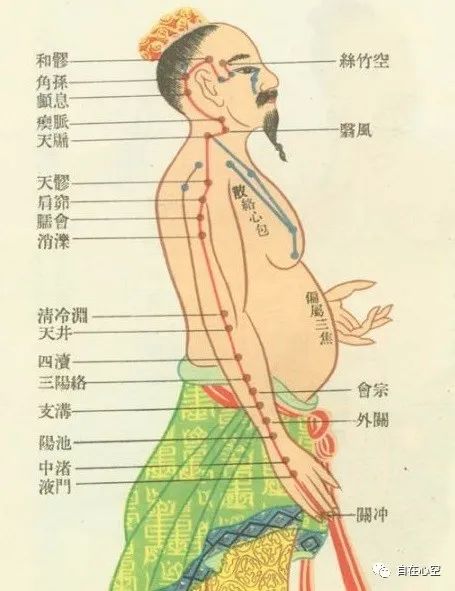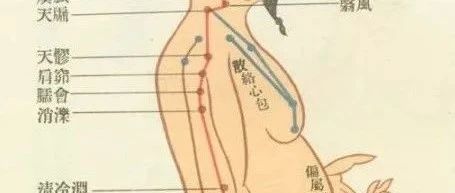The meridians and collaterals of the human body are analogous to the lines of longitude and latitude on Earth, with the meridians distributed longitudinally like the Earth’s longitude lines, while the collaterals connect the meridians transversely like latitude lines.
The collaterals are small branches that diverge from the meridians and spread throughout the body. The term “collateral” refers to a network. In the Ling Shu (Spiritual Pivot), it states: “The meridians are deep, while those that branch out horizontally are called collaterals,” indicating that the meridians are located deeper, while the branches that extend horizontally from the meridians are shallower and referred to as collaterals.
The collaterals primarily consist of fifteen main collaterals, including the Sun Luo (Collateral of the Small Branch), Xue Luo (Blood Collateral), and Fu Luo (Floating Collateral), which communicate with the meridians, circulate Qi and blood, and reflect and treat diseases. The Fu Luo and Sun Luo are widely distributed throughout the body.

【Fu Luo】 refers to the collaterals located just beneath the skin’s surface. Because they are superficial, they are named “floating.” The Fu Luo are the collaterals in the skin area, and each area’s Fu Luo corresponds to the adjacent meridians. From a modern medical perspective, the Fu Luo correspond to superficial veins, also known as blue veins.
Clinically, changes in their location and color can be used for diagnosis and treatment.
The Fu Luo is mentioned in classical TCM texts:
-
In the Suwen (Plain Questions), Chapter on the Skin: “Observe the areas with floating collaterals; they are all collaterals of Yangming (Taiyang, Shaoyang).”
-
Yang Shangshan’s notes in Taizu, Volume Nine, on the Meridians and Skin: “Floating refers to the large and small collaterals seen in the skin.”
-
Wu Kun’s annotations in the Suwen: “The floating collateral is the collateral that floats on the skin.”
【Sun Luo】: The small branches that diverge from the collaterals are called Sun Luo. In the Suwen, Chapter on Qi Points: “The Emperor said: I already know the locations of the Qi points and the places of wandering needles; I wish to know if the Sun Luo and valleys also correspond?” Wang Bing’s note: “Sun Luo refers to small collaterals, which are branches of the collaterals.” In the Ling Shu: “The meridians are deep, those that branch out horizontally are collaterals, and those that branch from collaterals are Sun Luo.” Their function, like that of the Fu Luo, is to distribute Qi and blood, nourishing the entire body.
From a modern medical perspective, the Sun Luo resembles capillaries in modern anatomy.
The Sun Luo is mentioned in classical TCM texts:
-
In the Suwen, Chapter on Qi Points: The Emperor said: “I already know the locations of the Qi points and the places of wandering needles; I wish to know if the Sun Luo and valleys also correspond?” Wang Bing’s note: “Sun Luo refers to small collaterals, which are branches of the collaterals.”
-
In the Ling Shu: “The meridians are deep, those that branch out horizontally are collaterals, and those that branch from collaterals are Sun Luo.”
-
Zhang Binglin’s On the System of Government: Tracing the meridians leads to the Sun Luo. Observing their Yin and Yang, tasting their odors. Their beginnings are minute, while their ends are vast, which cannot be comprehended by the masses, thus recorded in this text.
-
In the Ling Shu, Chapter on Pathogenic Factors and Organ Diseases: “The twelve meridians and three hundred sixty-five collaterals, their blood and Qi all rise to the face and flow through the orifices.”
In multiple chapters of the Neijing (Inner Canon), it discusses “Heaven has three hundred sixty-five days,” and the human body has 365 acupoints, collaterals, valleys, and joints corresponding to this number, as stated in the Suwen, Chapter on the Six Seasonal Organs: “Heaven uses the six sixes to complete a year; Earth uses the nine nines to gather, and humans also have three hundred sixty-five sections.” In the Regulation of the Menstrual Cycle: “Humans have essence, Qi, body fluids, four limbs, nine orifices, five organs, sixteen parts, and three hundred sixty-five sections… The twelve meridians all connect to three hundred sixty-five sections.” In the Qi Points: “I have heard that there are three hundred sixty-five Qi points corresponding to a year… In total, there are three hundred sixty-five points, through which needles pass… The Sun Luo has three hundred sixty-five meeting points, also corresponding to a year… The valleys have three hundred sixty-five meeting points, also corresponding to a year…” In the Qi Palace: “The points where the Qi emerges are all three hundred sixty-five points.” And in the Ling Shu, Chapter on Nine Needles and Twelve Origins: “The intersections of sections are three hundred sixty-five meetings… The term ‘sections’ refers to the places where the spirit and Qi circulate, not the skin, flesh, tendons, or bones.” In the Pathogenic Factors and Organ Diseases: “The twelve meridians and three hundred sixty-five collaterals, their blood and Qi all rise to the face and flow through the orifices.”
In the Qing Dynasty, Yu Jiayan’s Medical Laws of the Medical Gate: On the Method of Ming Collaterals: “The twelve meridians have been thoroughly discussed by the ancients, but the collaterals have not been adequately addressed, which is also a deficiency… The twelve meridians give rise to twelve collaterals, twelve collaterals give rise to one hundred eighty connecting collaterals, connecting collaterals give rise to one hundred eighty entangled collaterals, and entangled collaterals give rise to thirty-four thousand Sun Luo. The more they emerge from within, the finer they become.” This Sun Luo is not limited to 365, but is countless, resembling modern capillaries, and according to this reasoning, it may exceed one hundred million. Given the medical development of the time, it could not have been derived from dissection but rather inferred.

